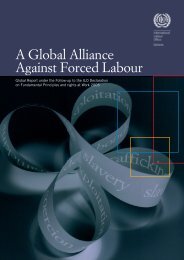equal by law, unequal by caste - International Dalit Solidarity Network
equal by law, unequal by caste - International Dalit Solidarity Network
equal by law, unequal by caste - International Dalit Solidarity Network
You also want an ePaper? Increase the reach of your titles
YUMPU automatically turns print PDFs into web optimized ePapers that Google loves.
330 Wisconsin <strong>International</strong> Law Journalthe greater <strong>caste</strong> structure; rather he or she is socially constructed inorder to ensure “upper-<strong>caste</strong>” privilege. Privileges or rights assigned ordenied to a particular <strong>caste</strong> are determined <strong>by</strong> that <strong>caste</strong>’s relationship toother <strong>caste</strong>s. The question human rights <strong>law</strong>yers must therefore startasking is not simply who is disadvantaged <strong>by</strong> discrimination, but whostands to benefit from it.Even with its inherent limitations, a faithful application of theConstitution of India—as human rights and constitutional scholar,Upendra Baxi, reminds us—would be a recipe for complete socialrevolution. 405 According to Jacobsohn, Baxi sees India as having both awritten and unwritten constitution where the written is the social justiceideology of the document, while the unwritten is the “antireformideology of the privileged classes and <strong>caste</strong>s, who, [Baxi] argues, havebeen quite successful in entrenching their version as constitutionalorthodoxy.” 406Defenders of each system have burned the words of the other ineffigy: just as medical students burned the writings of Dr. Ambedkar inanti-reservation protests in 2006, in 1927, Ambedkar set fire to the ManuSmriti, the ancient Hindu <strong>law</strong> book that Ambedkar believed sanctifiedand authorized the cruel treatment of <strong>Dalit</strong>s. 407 Both acts seek toannihilate that which symbolically stands between those who areaggrieved and that which they seek. For anti-reservations protestors,Ambedkar and his thoughts are the embodiment of undeserved <strong>Dalit</strong>“privilege,” while for <strong>Dalit</strong>s, the Manu Smriti stands in as the veritableBrahmin Bill of Rights.Even acts of simple revolution like the decision to extendreservations to include other “lower-<strong>caste</strong>” categories have contributed tothe resurgence of the Hindu Nationalist movement in India. 408 Themovement’s emphasis on cultural nationalism is seen as both an attemptto unite Hindus under one cultural, nationalistic banner and as an405 See UPENDRA BAXI, COURAGE, CRAFT AND CONTENTION: THE INDIAN SUPREME COURT IN THEEIGHTIES (1985).406 JACOBSOHN, supra note 402, at 233–34. See also Teltumbde, supra note 152, at 12: “The sorrystate of the executive compliance with . . . constitutional provisions amply bears out the fangs ofthe intrinsically iniquitous Indian society.”407 S. M. MICHAEL, UNTOUCHABLES: DALITS IN MODERN INDIA 58 (1999).408 See JACOBSOHN, WHEEL OF LAW, supra note 402, at 154 (describing the connection between theMandal Commission recommendation to extend reservations to “Other Backward Castes” andthe Hindu Nationalist campaign to demolish the Babri mosque and erect a Hindu templededicated to the Lord Ram in its place).
















